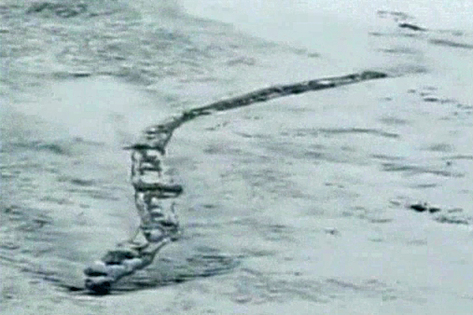
Monsters are both reflections of our basest fears and a complicated social topic. Monsters evolve to suit human needs. Sometimes that need is… publicity and tourism dollars.
The infamous Lagarfljótsormurinn of Iceland is a notorious snake-like monster that lives in Lake Lagarfljót in eastern Iceland. Apparently, the monster has been reported since 1345.
Lagarfljótsormurinn is back in the news once again as the Fljótsdalshérað council has declared a 2012 video of it as “real”. Science by democracy of a public council? That’s not how it works. This is not a real animal but it is a way to get people to notice your area and perhaps come visit to see the “worm” for yourself.
On the morning of 2 February 2012, Hjörtur E. Kjerúlf took a video out of his kitchen window in Hrafnkelsstaðir, Fljótsdalur. The video shows something undulating horizontally in the glacial river Jökulsá í Fljótsdal. The river is the largest tributary of Lake Lagarfljót. It does not appear to be a hoax - there really IS something in the river.
Take a look at the uncut video:
The first clue that it is NOT the Iceland worm (snake, serpent, dragon) is that it is February in Iceland in a glacial river chock full of ice. The thing undulates in a way that a mammal could not based on physiology - it’s very serpent like. A reptile could not exist under such icy conditions. Another rather critical point is that there are no native reptiles in Iceland. How could it be possible for a giant serpent to exist in a very cold stream coming from a glacier tongue of Vatnajökull, the largest glacier of Iceland.
The mystery of what this object in the water might be was solved in short order based on the video itself.
A Finnish woman (and friend of Doubtful News) Miisa McKeown told Discovery News that she had a passingly familiar with ice and how frozen objects behave in water. She could observe from the video that the water was flowing quickly past the object instead of the object moving through the water. She concluded that the “worm” was “a flexible object trapped there.”
Even the person who recorded the video, Hjörtur Kjerúlf, admitted that the animal moved, but did not advance relative to shore points. It appears to move upstream, but it actually does not. This is sound reasoning to conclude the object is an ice-encrusted fishing net, cloth, or plastic material that is caught in the current. It is not a living thing.
The Iceland Worm story made Doubtful News’ #3 best monster story of 2012.
As usually happens with these sensational monster sightings, the explanation is not as widely distributed as the original story. The Lagarfljóts’ worm kept resurfacing.
The district council of Fljótsdalshérað municipality had promised that if the monster would ever be caught on camera, the photographer would be entitled to the prize. Kjerúlf made claim to prize money offered some 15 years ago amounting to ISK 500,000 (USD 4,200, EUR 3,400).
The district council appointed a 13-person investigative commission, including a scientist, to evaluate whether the Kjerúlf video was really of the famous local creature. Last August (it took them two years), they ruled that Hjörtur’s video was authentic and awarded him the prize money. (As Internet news often goes, this story was resurrected this week on various sites arousing new interest and bringing the creature back into search results circulation.)
We don’t know for sure the reasoning behind the council’s conclusion but can make an informed guess based on what has been said in the media. The council seems to have taken a page from the Loch Ness playbook in “How to use the local monster lore to your advantage”. Lake monsters are one if not the most common “monster” to be exploited for tourist dollars across the globe. Serpent-like mystery animal sightings are well known through the U.S. and Canada, as well as South America, Africa, Europe, China, and even Russia. Lake monster stories are easy ways to sell boat tours, hotel rooms and campsites, tee shirts, toys, and oodles of gift shop kitsch. Lake Monsters even have their own festivals. In this case, "real" means "real tourist dollars and publicity".
The district commission in also recommended further studies of Lagarfjótsormurinn. Hjörtur also received an additional ISK 50,000 prize from the local tourism cooperative for having marketed the region as a tourist destination thanks to his video.
Local folklore stories give an area character, uniqueness, and can tell us something about the history and people. But, the richness is lost when we are asked to believe something so absurd is actually real. It cheapens the experience.
In case you are wondering how to pronounce Lagarfjótsormurinn (Lagarfljotsormur), here is a helpful video from Hlin from Iceland who provided me with this video after meeting at TAM 2012.


